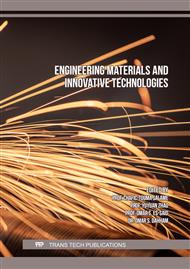[1]
ALDOSARI, Obaid, et al. Catalytic Hydrogenation of Furfural and Furfuryl Alcohol to Fuel Additives Andvalue-Added Chemicals., Turkish Journal of Chemistry, vol. 43, no. 1, 5 Feb. 2019, p.24–38, 10.3906/kim-1808-47.
DOI: 10.3906/kim-1808-47
Google Scholar
[2]
Claudy, Pierre, et al. Crude Oils and Their Distillates: Characterization by Differential Scanning Calorimetry., Fuel, vol. 67, no. 1, Jan. 1988, p.58–61, 10.1016/0016-2361(88)90012-9. Accessed 14 May (2022).
DOI: 10.1016/0016-2361(88)90012-9
Google Scholar
[3]
Fuels., Techno Oil Limited - the Future of Energy, technooil.com/fuels/#:~:text=Premium% 20Motor%20Spirits%20(PMS). Accessed 14 May (2022).
Google Scholar
[4]
Gasoline., Wikipedia, 9 Apr. 2022, en.m.wikipedia.org/wiki/Gasoline.Henshaw, Terry, and Ify Nwaogazie.
Google Scholar
[5]
Gasoline Winter Oxygenates., Www.epa.gov, 7 Aug. 2015, www.epa.gov/gasoline-standards/gasoline-winter-oxygenates#:~:text=Oxygenates%20are%20fuel%20additives%20that.Vallinayagam, R., et al.
DOI: 10.1021/bk-2002-0799.fw001
Google Scholar
[6]
What Are Fuel Additives? - Definition from Corrosionpedia., Corrosionpedia, www.corrosionpedia.com/definition/1625/fuel-additives-corrosion. Accessed 14 May 2022.Wu, Bencheng, et al.
Google Scholar
[7]
News, Petro Industry. What Does RON and MON Mean?, Petro Online, www.petro-online.com/news/analytical-instrumentation/11/breaking-news/what-does-ron-and-mon-mean/55661#:~:text=In%20the%20UK%2C%20the%20standard. Accessed 14 May (2022).
Google Scholar
[8]
Victorovich Zablotsky, Yuriy, and Sergey Victorovich Sagin. Enhancing Fuel Efficiency and Environmental Specifications of a Marine Diesel When Using Fuel Additives., Indian Journal of Science and Technology, vol. 9, no. 46, 28 Dec. 2016, 10.17485/ijst/2016/v9i46/107516. Accessed 14 May (2022).
DOI: 10.17485/ijst/2016/v9i46/107516
Google Scholar
[9]
Rodríguez-Antón, Luis Miguel, et al. Experimental Determination of Some Physical Properties of Gasoline, Ethanol and ETBE Blends., Fuel, vol. 112, Oct. 2013, p.178–184, 10.1016/j.fuel.2013.04.087. Accessed 6 Apr. 2022.---.
DOI: 10.1016/j.fuel.2013.04.087
Google Scholar
[10]
Nano Additives Influence on Fuel Oil Properties., Solid State Phenomena, vol. 265, Sept. 2017, p.374–378, 10.4028/www.scientific.net/ssp.265.374. Accessed 14 May (2022).
DOI: 10.4028/www.scientific.net/ssp.265.374
Google Scholar
[11]
Shabnam, et al. Phytonanotechnology: A New Horizon for the Food Industry., Phytonanotechnology, 2020, p.221–244, 10.1016/b978-0-12-822348-2.00012-7. Accessed 14 May (2022).
DOI: 10.1016/b978-0-12-822348-2.00012-7
Google Scholar
[12]
Khan, Saddam, et al. Nanoparticles as Fuel Additive for Improving Performance and Reducing Exhaust Emissions of Internal Combustion Engines., International Journal of Environmental Analytical Chemistry, 5 Feb. 2020, p.1–23, 10.1080/03067319.2020.1722810. Accessed 9 Dec. (2020).
DOI: 10.1080/03067319.2020.1722810
Google Scholar
[13]
Nano-Additives Show Promise in Reducing Friction and Wear., F&L Asia, www.fuelsandlubes.com/fli-article/nano-additives-show-promise-in-reducing-friction-and-wear/. Accessed 14 May (2022).
Google Scholar
[14]
The Physical and Chemical Effects of Fuel on Gasoline Compression Ignition., Repository.kaust.edu.sa, SAE International, 2 Apr. 2019, repository.kaust.edu.sa/handle/10754/653044. Accessed 14 May (2022).
Google Scholar
[15]
Fakoya, Muili Feyisitan, and Subhash Nandlal Shah. Emergence of Nanotechnology in the Oil and Gas Industry: Emphasis on the Application of Silica Nanoparticles., Petroleum, vol. 3, no. 4, Dec. 2017, p.391–405, 10.1016/j.petlm.2017.03.001.
DOI: 10.1016/j.petlm.2017.03.001
Google Scholar
[16]
Zhe, Zhang, and An Yuxiu. Nanotechnology for the Oil and Gas Industry – an Overview of Recent Progress., Nanotechnology Reviews, vol. 7, no. 4, 28 Aug. 2018, p.341–353, 10.1515/ntrev-2018-0061.Zvereva, E.R., et al.
DOI: 10.1515/ntrev-2018-0061
Google Scholar
[17]
Liquefied Petroleum Gas (LPG) as a Medium-Term Option in the Transition to Sustainable Fuels and Transport., Renewable and Sustainable Energy Reviews, vol. 32, 1 Apr. 2014, p.513–525, www.sciencedirect.com/science/article/abs/pii/S136403211400063X, 10.1016/j.rser. 2014.01.052. Accessed 1 Sept. (2021).
DOI: 10.1016/j.rser.2014.01.052
Google Scholar
[18]
Onojake, M.C., et al. Behavioural Characteristics of Adulterated Premium Motor Spirit (PMS)., Egyptian Journal of Petroleum, vol. 21, no. 2, Dec. 2012, p.135–138, 10.1016/j.ejpe.2012.11.004. Accessed 17 Sept. (2020).
DOI: 10.1016/j.ejpe.2012.11.004
Google Scholar
[19]
Climent, Maria J., et al. Conversion of Biomass Platform Molecules into Fuel Additives and Liquid Hydrocarbon Fuels., Green Chemistry, vol. 16, no. 2, 2014, p.516, 10.1039/c3gc41492b. Accessed 18 Mar. (2020).
DOI: 10.1039/c3gc41492b
Google Scholar
[20]
Experimental Determination of Some Physical Properties of Gasoline, Ethanol and ETBE Ternary Blends." Fuel, vol. 156, Sept. 2015, p.81–86, 10.1016/j.fuel.2015.04.040.---. ,.
DOI: 10.1016/j.fuel.2015.04.040
Google Scholar
[21]
Physical Properties of Gasoline, Isobutanol and ETBE Binary Blends in Comparison with Gasoline Ethanol Blends." Fuel, vol. 166, Feb. 2016, p.73–78, 10.1016/j.fuel.2015.10.106. Accessed 28 Mar. (2020).
DOI: 10.1016/j.fuel.2015.10.106
Google Scholar
[22]
Setting Regulatory Limits for Sulphur Content in Premium Motor Spirit (PMS): A Case of Degraded Vehicles., Archives of Current Research International, vol. 7, no. 3, 10 Jan. 2017, p.1–17, 10.9734/acri/2017/33241.
DOI: 10.9734/acri/2017/33241
Google Scholar
[23]
Tüccar, Gökhan, et al. Investigations of Effects of Density and Viscosity of Diesel and Biodiesel Fuels on NOx and Other Emission Formations., Academic Platform Journal of Engineering and Science, vol. 6, no. 2, 3 Aug. 2018, p.81–85, dergipark.org.tr/tr/download/article-file/519001, 10.21541/apjes.371015. Accessed 20 June 2021.US EPA, OAR.
DOI: 10.21541/apjes.371015
Google Scholar
[24]
E10 Petrol Explained: What Is It and Can My Car Run on It?" Carwow.co.uk, www.carwow.co.uk/blog/e10-petrol-explained-what-is-it-can-my-car-use-it#gref.Elert, Glenn. "Glenn Elert.,.
Google Scholar
[25]
How Much Ethanol Is in Gasoline, and How Does It Affect Fuel Economy? - FAQ - U.S. Energy Information Administration (EIA)." Eia.gov, 2016, www.eia.gov/tools/faqs/faq.php,id=27&t=10.Kasper, M, et al.
Google Scholar
[26]
Fuel Properties and Emissions., Dieselnet.com, dieselnet.com/tech/fuel_emi.php. Accessed 26 Apr. (2022).
Google Scholar
[27]
WEBERDEMENEZES, E, et al. Effect of Ethers and Ether/Ethanol Additives on the Physicochemical Properties of Diesel Fuel and on Engine Tests., Fuel, vol. 85, no. 5-6, Mar. 2006, p.815–822, 10.1016/j.fuel.2005.08.027. Accessed 18 Mar. (2021).
DOI: 10.1016/j.fuel.2005.08.027
Google Scholar
[28]
Hypertextbook.com, hypertextbook, 2009, hypertextbook.com/facts/2007/ArtemGindin.shtml.
Google Scholar
[29]
Distribution and Identification of Chlorides in Distillates from YS Crude Oil., Energy & Fuels, vol. 29, no. 3, 19 Feb. 2015, p.1391–1396, 10.1021/ef502450w. Accessed 14 May 2022.Yan, Kai, et al.
DOI: 10.1021/ef502450w
Google Scholar
[30]
Production, Properties and Catalytic Hydrogenation of Furfural to Fuel Additives and Value-Added Chemicals., Renewable and Sustainable Energy Reviews, vol. 38, Oct. 2014, p.663–676, 10.1016/j.rser.2014.07.003. Accessed 1 Sept. (2020).
DOI: 10.1016/j.rser.2014.07.003
Google Scholar
[31]
The Influence of Fuel Additives on the Formation of Carbon during Combustion., Journal of Aerosol Science, vol. 30, no. 2, Feb. 1999, p.217–225, 10.1016/s0021-8502(98)00034-2. Accessed 14 May (2022).
DOI: 10.1016/s0021-8502(98)00034-2
Google Scholar
[32]
Differences between Diesel and Petrol Explained." ACEA - European Automobile Manufacturers, Association, 24 Sept. 2016, www.acea.auto/fact/differences-between-diesel-and-petrol/.
Google Scholar


